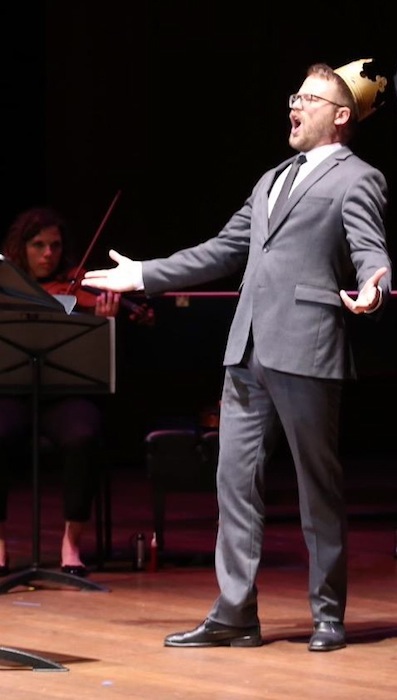Contempo takes a walk on the wild side with 20th-century theatrical works

For the first program of its 52nd season, Contempo presented a not-so-contempo program, with the Talea Ensemble performing 20th-century instrumental-theater works Friday night at the Logan Center.
All four unorthodox hybrids on tap would have been called avant garde in their day, and only one of these musico-theatrical works has established a hold on the repertory. That item–by Peter Maxwell Davies–also happens to be by far the most successful piece, which says something about posterity’s musical judgment being more right than wrong.
The University of Chicago Presents event felt something like a quaint exhibition of what passed for cutting-edge arts experimentation a half-century or more ago. Yet with the versatile, New York-based Talea Ensemble delivering full-blooded, unapologetic advocacy for all four works, it proved an undeniably entertaining musical tour indeed.
The program led off with Karlheinz Stockhausen’s Der kleine Harlekin (1976). The 12-minute work depicts various character aspects of the Harlequin figure, who is portrayed in music and movement by a solo clarinetist. Rane Moore proved a wonderfully versatile protagonist. Clad in space-age, black and white garb, Moore gamely tackled the unusual demands of this commedia dell’arte role. Talea’s clarinetist played Stockhausen’s spare lines and rapid bursts with unerring musicality, while providing percussion with foot stamping, in addition to dancing, reclining and, at one point, exiting and reentering the hall by the side door.
Mauricio Kagel takes the theatrical element into the realm of the surreal with his Sur Scène (1960). In this infamous work, a speaker delivers a lecture on “the crisis in contemporary music,” which begins in outwardly reasonable style though it soon becomes clear that the lecture is complete gobbledygook.
The humor of the piece may be somewhat inscrutable for many, with the 45-minute length part of the send-up. Yet Kagel’s “lecture” itself is a brilliant piece of social satire, with its mix of cliched bromides, academic jargon, formless syntax, and assorted pretentiousness. If anything, Kagel’s heat-seeking missile aimed at a certain stream of insular academic cluelessness seems just as relevant today (though more from politicized cultural studies enclaves than music departments).
Talea’s director Rick Burkhardt was dead on in the speaker’s role, speaking in the rhythms and practiced cadences of a college professor, which made the spoken absurdities even more hilarious, not least when he accelerates the jumble of words to a frantic pace delivered in a falsetto.
In this performance Talea gives Burkhardt a break by having the middle section of his interminable lecture played back from a recording. The group gilded the lily somewhat by electing to make Sur Scène into even more of a Dadaist exercise than it already is, adding a mime (Benjamin Domask), three ensemble members and baritone Michael Weyandt. The others provide assorted strange sounds and gestures, abrupt piano and percussion puncuation, and divers physical comedy, even chasing Burkhardt around the stage.
The most substantial rewards of the evening came with Peter Maxwell Davies’ Eight Songs for a Mad King. Written in 1969, this extraordinary work for vocal soloist and chamber ensemble put the English composer on the map, and still packs a wallop. The scenes, flowing together in an unbroken half-hour, depict the incipient madness of King George III, with Davies drawing his musical material from eight melodies played on a mechanical organ owned by the monarch.
Davies, who died this past March, musically reflects the unmoored royal’s mental flights and dislocations in almost clinical fashion with sudden jagged violin figures, crashing piano chords, and screeching winds. Amid the jarring musical explosions, there are fitful respites, including spare, fragmented string and piano solos and echoes of stability in the harpsichord’s rococo soothings.
Soloist Michael Weyandt delivered a riveting tour de force performance. Whether taking selfies with his cell phone–later smashing it to pieces–confronting Talea musicians in his crazed rants, or screaming in violent desperation, Weyandt painted the king’s unhinged fury with alarming manic intensity. Yet the young baritone also made the king a sympathetic and pitiable figure, taking nostalgic solace in happier times and, in his pleading whispers, attempting to make sense of his declining mental state. Led by conductor Jeffrey Means, the knife-edged playing of the Talea musicians and director Burkhardt’s resourceful lighting and direction added to the impact of this powerful performance.
In many ways it was John Cage who started the theatrical music movement–for better or worse–so it was fitting that the evening closed with a work by the pioneering American modernist.
After what had gone before, Cage’s Living Room Music (1940) seemed almost old-fashioned. The 12-minute work for “objects of everyday use” began with two Talea members drumming on the room’s aisle balustrades, later moving to the stage where more members provided percussion of rhythmic ingenuity on the floor. A serving cart was rolled out and the percussion moved seamlessly to utilizing the glasses, wine bottles and plates. The performance ended, and the audience was invited by the Talea Ensemble to join them on stage and open the bottles for an impromptu reception. Many did and why not?
Posted in Performances




